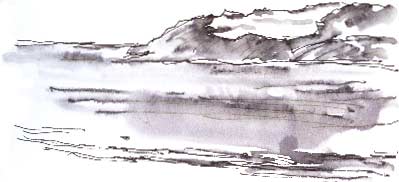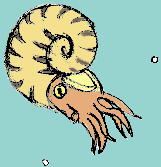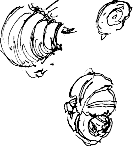
 THOSE
LINES in the foreground of my Art Pen and waterbrush drawing
of Robin Hood's
Bay (right), are arcing exposures of Jurassic rocks which
have been domed upwards by earth movements. Stuart, a local
geologist, tells me
that those particular beds are the mudstones - some shelly, some sandy - of
the Echioceras raricostatum zone. Echioceras raricostatum is
an ammonite that gives its name to this particular set of strata.
THOSE
LINES in the foreground of my Art Pen and waterbrush drawing
of Robin Hood's
Bay (right), are arcing exposures of Jurassic rocks which
have been domed upwards by earth movements. Stuart, a local
geologist, tells me
that those particular beds are the mudstones - some shelly, some sandy - of
the Echioceras raricostatum zone. Echioceras raricostatum is
an ammonite that gives its name to this particular set of strata.
Shells all over the place
 Ammonites were
free-swimming creatures, resembling a squid in a shell, like a modern nautilus,
so their shells ended up falling to the seabed in a variety of habitats.
My animation shows a goniatite which was a forerunner of the ammonites.
Ammonites were
free-swimming creatures, resembling a squid in a shell, like a modern nautilus,
so their shells ended up falling to the seabed in a variety of habitats.
My animation shows a goniatite which was a forerunner of the ammonites.
The
shell could float a long way after the creature had died, as it was
divided into
chambers,
which the creature could
fill
with
water or gas to control buoyancy.
Their
shells
evolved
steadily
over time so that you
can correlate mudstones, limestone,
ironstone and sandstones over a wide area because their shells got all over
the place.
Peterborough museum has a sauropod vetrebra the size of a cake tin
with impression of ammonite shells on its surface. The sauropod, a brontosaurus
type of dinosaur, lived on land - and probably wandered along the shore
on many occasions. After death, the body or parts of the body must have
floated
out to sea as the bone was found in an Oxford Clay brick pit.
 Pound
Stone
Pound
Stone
 Further
down the coast, we take a look at a wall constructed
in a rustic kind of way from assorted chunks of a shelly limestone from the
Hambleton
group of Jurassic rocks. These chunks haven't fallen from the cliffs, as I
guessed when I saw them, but they're from a local quarry, so the fossils are
similar.
Further
down the coast, we take a look at a wall constructed
in a rustic kind of way from assorted chunks of a shelly limestone from the
Hambleton
group of Jurassic rocks. These chunks haven't fallen from the cliffs, as I
guessed when I saw them, but they're from a local quarry, so the fossils are
similar.
Stuart spotted this fossil sea urchin (left, below),
called Clypeus from
the Latin meaning shield-shaped but it's also known as a pound stone,
as the fossil - which you could hold in the palm of your hand - weighed approximately
one pound and was used, for example, by dairy maids for weighing butter.
My
thanks to Mike
Windle for that story; Mike tells me that William Smith (1769
-1839),
'the father of English geology' who was born in Oxfordshire, was familiar
with this fossil because he would often have seen it in use at local farms.
He became convinced that it was the shell of a living creature, not a meaningless
'sport of nature', which was one of the explanations for fossils at that
time.

 THOSE
LINES in the foreground of my Art Pen and waterbrush drawing
of Robin Hood's
Bay (right), are arcing exposures of Jurassic rocks which
have been domed upwards by earth movements. Stuart, a local
geologist, tells me
that those particular beds are the mudstones - some shelly, some sandy - of
the Echioceras raricostatum zone. Echioceras raricostatum is
an ammonite that gives its name to this particular set of strata.
THOSE
LINES in the foreground of my Art Pen and waterbrush drawing
of Robin Hood's
Bay (right), are arcing exposures of Jurassic rocks which
have been domed upwards by earth movements. Stuart, a local
geologist, tells me
that those particular beds are the mudstones - some shelly, some sandy - of
the Echioceras raricostatum zone. Echioceras raricostatum is
an ammonite that gives its name to this particular set of strata. Ammonites were
free-swimming creatures, resembling a squid in a shell, like a modern nautilus,
so their shells ended up falling to the seabed in a variety of habitats.
My animation shows a goniatite which was a forerunner of the ammonites.
Ammonites were
free-swimming creatures, resembling a squid in a shell, like a modern nautilus,
so their shells ended up falling to the seabed in a variety of habitats.
My animation shows a goniatite which was a forerunner of the ammonites. Pound
Stone
Pound
Stone Further
down the coast, we take a look at a wall constructed
in a rustic kind of way from assorted chunks of a shelly limestone from the
Hambleton
group of Jurassic rocks. These chunks haven't fallen from the cliffs, as I
guessed when I saw them, but they're from a local quarry, so the fossils are
similar.
Further
down the coast, we take a look at a wall constructed
in a rustic kind of way from assorted chunks of a shelly limestone from the
Hambleton
group of Jurassic rocks. These chunks haven't fallen from the cliffs, as I
guessed when I saw them, but they're from a local quarry, so the fossils are
similar.